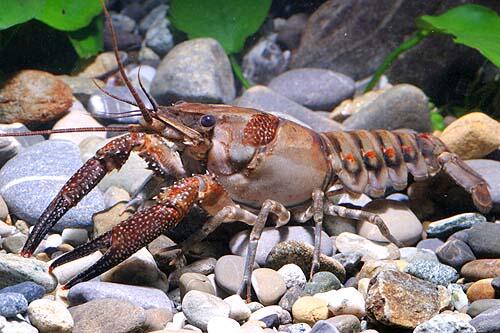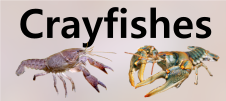







Loading profile. Please wait . . .
Procambarus petersi Hobbs, 1981
Ogeechee Crayfish




Federal Protection: No US federal protection
State Protection: No Georgia state protection
Global Rank: G3
State Rank: SU
Element Locations Tracked in Biotics: Yes
SWAP 2015 Species of Greatest Conservation Need (SGCN): Yes
SWAP 2025 Species of Greatest Conservation Need (SGCN): Yes
2025 SGCN Priority Tier: Data Deficient
Element Occurrences (EOs) in Georgia: 16
Habitat Summary for element in Georgia: Flowing waters with rocks, woody debris, leaf litter, or undercut banks
The overall appearance of the Ogeechee Crayfish is tan to brownish or olive with darker markings. The carapace has a dark saddle near its rear edge that extends forward on either side of the carapace as two “horns.” The most obvious pigmentation characteristics are the discrete reddish or purplish spots along the margins of the abdomen. The palms of the claws are dark with light tubercles. The areola is wide and the rostrum is long and sharply pointed with marginal spines; there are two distinctive cervical spines on either side of the carapace. Adult Ogeechee Crayfish may reach a maximum total body length of over 105 mm (>4 in).
Within its range, no other crayfish species has paired cervical spines on either side of the carapace.
The Ogeechee Crayfish is found in a wide array of flowing water habitats across its range. Depending on the substrates available it can be found hiding beneath rocks, within woody debris or leaf litter, and beneath undercut banks.
No studies of the Ogeechee Crayfish diet are known. Crayfishes are considered opportunistic omnivores and likely feed on live and decaying vegetation, aquatic insect larvae, small fishes, and dead animal matter.
Stream dwelling crayfishes typically hide during the day and come out at night to feed. Reproduction usually occurs during the spring and fall, but males in reproductive condition may be found at any time during the year. When female crayfish are ready to lay eggs, they usually find a secure hiding place and hence are rarely encountered. When the eggs are released, the female attaches them to her swimmerets and is said to be “in berry.” Upon hatching, the juvenile crayfish are attached to the mother by a thread. After the juveniles molt for the second time, they are free of the mother, but stay close and will hold on to her for some time. Eventually they move off on their own. Crayfishes molt 6 or 7 times during their first year of life and most are probably able to reproduce by the end of that year. They molt once or twice a year for the remainder of their lives and live about 3 years. Males in reproductive condition have been collected in only June and no females with eggs or young have been found. The smallest reproductive male is about 90 mm (3.5 in) in length (Hobbs 1981).
This species most likely inhabits streams with woody debris or vegetation and will likely be hiding in those areas. Kicking into a seine or dipnet through vegetation or leaf packs may yield this species. Shocking downstream into a seine net with a backpack electroshocker and setting baited minnow traps overnight are also effective.
The Ogeechee Crayfish is known only from the Ogeechee and Canoochee rivers in eastern Georgia (Hobbs 1981).
The Ogeechee Crayfish is threatened in Georgia by its small geographic range and land uses within that range that could alter hydrology and water quality. Introduction of a non-native species into the Ogeechee River system would likely threaten this species.
| Threat 1 | Threat 2 | Threat 3 | |
|---|---|---|---|
| General Threat | Pollution | Pollution | Natural system modifications |
| Specific Threat | Agricultural & forestry effluents | Industrial & military effluents | Dams & water management/use |
This species is poorly known but is considered stable at this time. Populations in the Canoochee River and its tributaries on the Fort Stewart army installation are somewhat protected.
General watershed level protection measures will help secure the continued existence of the Ogeechee Crayfish in Georgia. These include the protection of riparian zones, control of sediment and nutrient runoff from farms and construction sites, and limiting the amount of impervious cover (e.g., pavement) within occupied watersheds. Non-native crayfishes should never be used for bait. Instead, anglers should use crayfishes collected from the river system they will be fishing in and should never release unused bait crayfish back into Georgia waters.
Hobbs, H.H.,Jr. 1981. The crayfishes of Georgia. Smithsonian Contributions to Zoology 318:1–549.
Taylor, C.A., G.A. Schuster, J.E. Cooper, R.J. DiStefano, A.G. Eversole, P. Hamr, H.H. Hobbs III, H.W. Robison, C.E. Skelton, and R.F. Thoma. 2007. A reassessment of the conservation status of crayfishes of the United States and Canada after 10+ years of increased awareness. Fisheries 32:372–389.
Christopher E. Skelton
C. Skelton, 2012: original account
C. Skelton, January 2019: general update of account.
DW, August 2019: Added Lukhaup photo